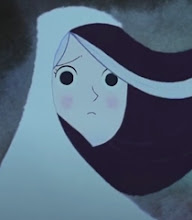It's a sunny spring afternoon. All of the members of my household are taking a nap after a busy week. I'm a less successful napper, and am relaxing by catching up with unread literary journals and drinking Żubrówska Bison Grass Vodka. This vodka is from a Polish friend who insists that it should be mixed with apple juice. Can this be true? It doesn't sound very Polish, but tastes delicious together.So what's with the bison and the grass? The vodka is flavored with a tincture of buffalo grass (Hierochloe odorata). This grass grows in the Białowieża Forest, which is partly in Poland and partly in Belarus, and elsewhere. A blade of buffalo grass is placed in each bottle of Żubrówka but it is only decorative and not the cause of the beverage’s taste and yellowish color.
The name Żubrówka comes from żubr or zubr, the Slavic word for the wisent (European bison), an animal that is particularly fond of eating buffalo grass.
The Reader has an interesting review of David Garnett's Lady Into Fox by Michael Caines. I'll reproduce it here while enjoying my drink.
David Garnett was a lucky man: he had a fox for a wife.
She was a person, according to her sister, Frances Partride, 'reserved almost to shyness but perfectly self-possessed', and in The Flowers of the Forest (1956), her husband likened her to 'a woodland creature': 'among the beeches and the pines I saw her as I could never see her in London'. Rachel Alice Marshall, 'Ray' to her friends, 'R.A. Garnett' to readers of the books she illustrated, was with her husband in the woods near his parents' home one day, when their vain attempt to spot some fox cubs caused him to say, "There's no hope of seeing a fox - unless you were suddenly to turn into one. You might. I should not really be much surprised if you did'. 'You must write that as a story', said Ray, reminding him that he had recently bought a copy, with woodcuts, of Ovid's Metamorphoses.
The Garnetts had married in 1921, and Lady Into Fox appeared the following year, it made Garnett's name. Ray provided both the model for Silvia Tebrick - the lady who, within a few of its pages, turns into a fox - and her own woodcuts. David provided the words. The novella strikes a blance somehow between whimsical sophistication and being seriously concerned with the workings of love and loyalty.
Perhaps it is the husband who triggers his wife's metamorphosis. (The narrator calls it a miracle). Does Richard Tebrick betray his wife by turning his head away from her for one moment, while they are walking near their Oxfordshire home? When he turns it back, "Where his wife had been the moment before was a small fox, of very bright red."
This fox's beseeching gaze and demure behavior convince Richard that it is Silvia indeed. He puts her under his coat and whisks her home. The real trouble begins after the transformation has taken place. Husband promises to stick by wife, dismisses the servants, shoots the dogs, and lives in fear of the hunting season. Wife plays cards with husband, and struggles into dresses in order to cover her (furry) nakedness. Husband despairs as wife begins to take a less modest interest in chasing wildfowl.
'This womanliness in her never failed to delight him, for it showed she was still his wife, buried as it were in the carcass of a beast but with a woman's soul.' The less delightful beast is also present, however, and it has more interest in eating its meat raw and running wild than in piquet and the piano indoors. Richard's love is tested by his wife's attempts at escape. Her instantaneous physical transformation is less awful, it would seem, than the gradual but ineluctable mental shifting that is the true source of their tragedy.
Lady into Fox has stayed in print, in several languages, with good reason: it is, as the narrative promises, a 'strange' and resonant tale, its civilized prose rendering it all the stranger. If this Hesperus edition has advantages over its predecessors, they are threefold: its pleasing format, the inclusion of R.A. Garnett's woodcuts (not to be taken for granted) and John Burnside's insightful foreword.
Saturday, April 18, 2009
Subscribe to:
Post Comments (Atom)








You are describing Tatanka
ReplyDeleteLong a favorite of Poland and its Baltic neighbors, it has finally made its way stateside thanks to those fabulous Russians who landed on our shores en masse during the early nineties. This is a drink that not many people know about, but once you’ve had it, you’ll keep coming back for more.
The beauty of Tatanka is in its simplicity. Composed of flavors that normally reside on polar extremes of the beverage spectrum, Tatanka will surprise and delight even the most hardnosed cynic. The velvety, grassy accents of the Zubrowska (bison grass) vodka, the innocent sweetness of the apple juice, stand in sharp contrast to the citrusy accents of lemon, but each complement the other beautifully, creating a delicious, decadent ménage a trois of flavors.
Tatanka recipe:
1 oz Zubrowka® vodka
4 oz apple juice